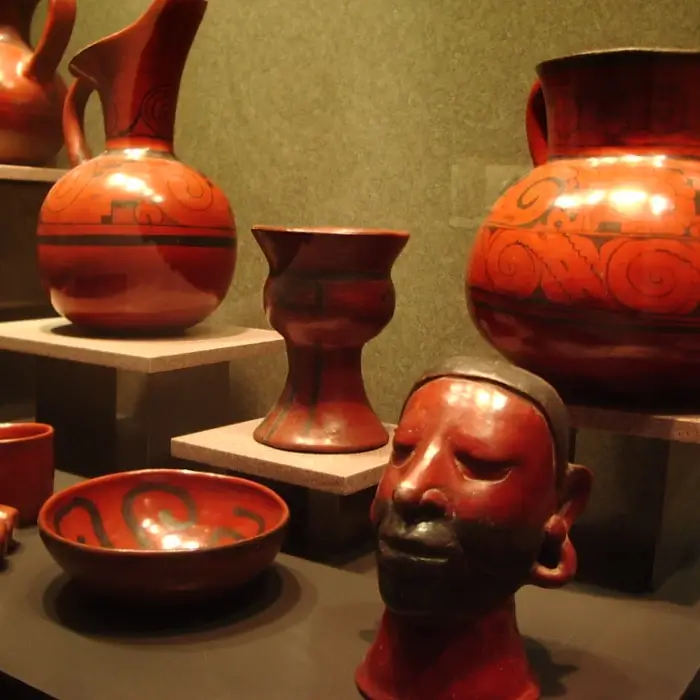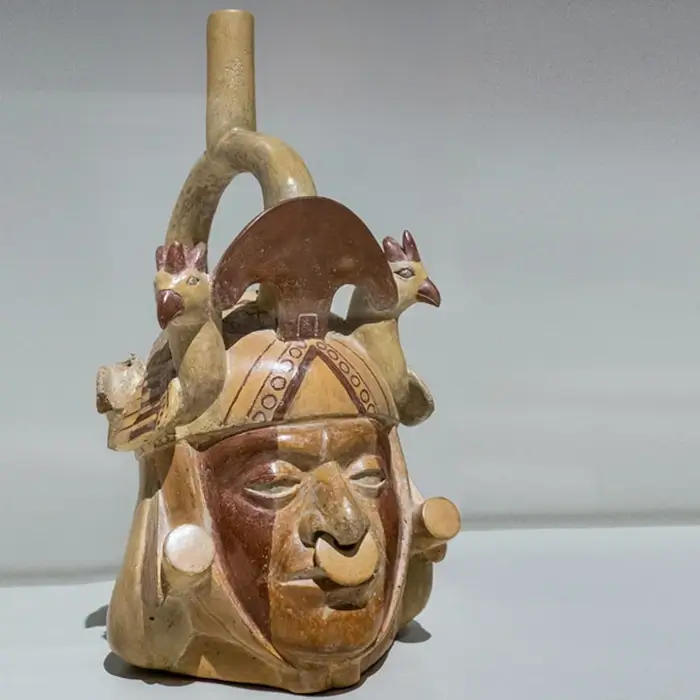The secrets of Teotihuacan ceramics revealed
Teotihuacan ceramics, emblematic art of one of the most influential cities of ancient Mesoamerica, exudes mystery and master craftsmanship.
This artistic legacy, which flourished between the first and seventh centuries A.D., reflects not only the technical skill of its creators, but also their deep spiritual and cultural connection. Ranging from utilitarian to ritual objects, Teotihuacan ceramics are a silent testimony of a civilization that, despite its disappearance, continues to fascinate and teach through its creations.
We invite you to learn the secrets of this art, which has transmitted to us not only its aesthetic beauty, but also a deep respect for the ingenuity and cosmovision of the Teotihuacanos.
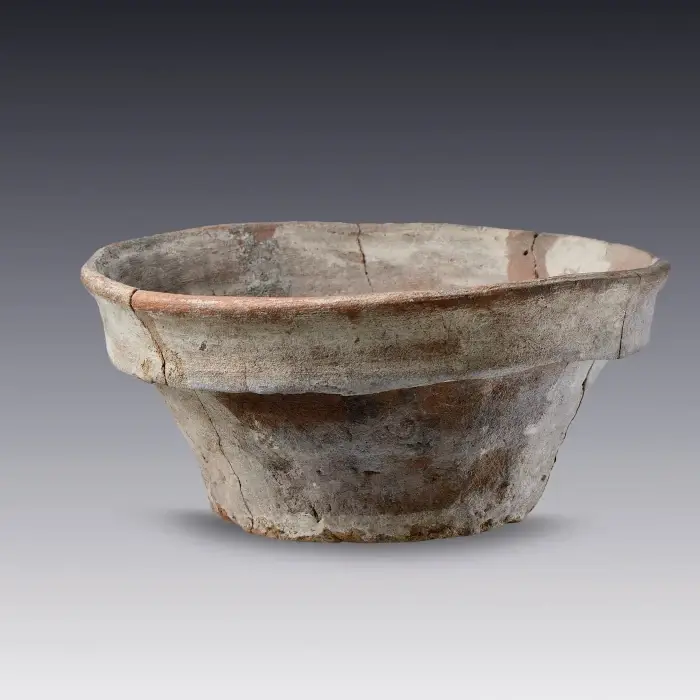
Origins and history of Teotihuacan pottery
Teotihuacan pottery emerges as one of the most eloquent testimonies of the civilization that inhabited the emblematic city of Teotihuacan, which was located in what is now central Mexico, flourishing from approximately 100 BC to 250 AD.
This city, known for its monumental architecture characterized by the pyramids of the Sun and the Moon, became a melting pot of cultures and a hub of trade in Mesoamerica, influencing later civilizations with its art and architecture.
The origins of ceramics in this region are closely linked to the social and commercial dynamics of Teotihuacan. Among the most significant finds is a type of fine ware that evidences advanced knowledge of manufacturing techniques and became an important trade item throughout Mesoamerica.
Teotihuacan pottery not only served utilitarian purposes but also played a crucial role in the rituals and symbolic expression of the city, reflecting the complexity and cultural richness of the Teotihuacan people.
As we progress through this article, we will explore the distinctive characteristics and creative processes that make this pre-Columbian ceramic unique, as well as its cultural importance and presence in collections and exhibitions around the world.
Main characteristics of Teotihuacan pottery
The ceramics of Teotihuacan, renowned for their exceptional quality and refined aesthetics, reflect the advanced understanding and skill of its craftsmen, a city that was an important cultural and commercial center in Mesoamerica between 100 B.C. and A.D. 700.
This type of pottery is distinctive for its unique shapes and decorations, ranging from round dishes with three rectangular feet to bulbous vessels with minimalist geometric designs, intricate censers and dynamic figurines that often feature molded additions and stamped decorations, suggesting a degree of mass production.
Teotihuacan pottery stands out for its complexity and diversity, reflecting the advanced knowledge and skill of its craftsmen. This pottery is characterized by a wide range of forms and techniques, including from three-footed plates to vessels decorated with geometric motifs and figurines with modeled and stamped details, suggesting a specialized production.
One of the most outstanding characteristics of Teotihuacan pottery is its talud-tablero style, visible in the architecture but also reflected in the ceramics, which demonstrates the interconnection between different art forms within the Teotihuacan culture.
In addition, this pottery is distinguished by the use of orange clay, decorated with stucco, which indicates a specialization in finishing and decoration techniques that made it highly demanded throughout Mesoamerica.
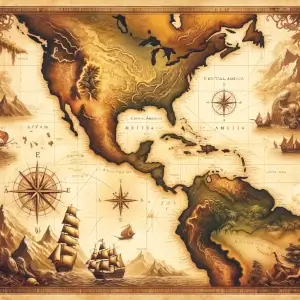
Where was each pre-Columbian culture?
Check our interactive map to see its period and location.
The importance of Teotihuacan in the Mesoamerican context is underscored by the presence of its craftsmanship in various regions, indicating extensive commercial and cultural networks. This interaction with different cultures is reflected in the stylistic diversity of Teotihuacan ceramics that incorporate elements of various Mesoamerican traditions, demonstrating the influence and reach of Teotihuacan beyond its borders.
In the following sections of the article, we will further explore the techniques and processes behind the creation of these ceramic pieces, as well as their cultural significance and their legacy in current collections and exhibitions.
Techniques and processes in the creation of Teotihuacan ceramics
Teotihuacan pottery, known for its quality and variety, reflects the advanced skills of the artisans of this ancient metropolis. From the preparation of the clay to the decorative techniques, each step of the process was meticulous and detailed.
Teotihuacan artisans used local clay, which was carefully selected and prepared to ensure the consistency and quality of the material. Decoration methods included the use of stucco and paint, as well as smoothing to achieve smooth surfaces and fine finishes.
A notable characteristic of Teotihuacan ceramics was their decoration. Techniques such as the addition of moldings and stamped decoration were employed, suggesting a degree of mass production. These techniques allowed for the creation of complex and detailed designs, which were often applied to a variety of ceramic forms, from plates to censers to figurines. Minimalist aesthetics and geometric designs were common, reflecting the worldview and aesthetic values of Teotihuacan society.
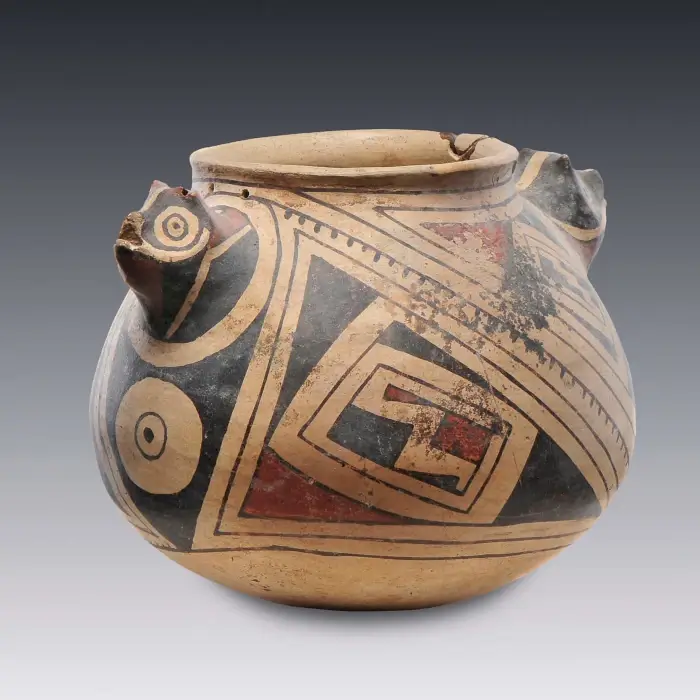
Buy pre-Columbian ceramics
Find original pieces and also reproductions identical to the traditional ceramic works that were made in pre-Columbian America and that are only found in museums, making them affordable.
The trade of Teotihuacan handicrafts was a crucial economic activity for this pre-Columbian people. Ceramic pieces were not only used within the city, but were also traded with distant regions, which demonstrates the importance and value given to these objects. Teotihuacan pottery was appreciated for its beauty and functionality, becoming a prized commodity throughout Mesoamerica.
In the following sections, we will further explore the cultural importance of Teotihuacan ceramics and how their techniques and styles influenced other Mesoamerican cultures, as well as their presence in collections and exhibitions around the world.
Cultural significance of Teotihuacan ceramics
Teotihuacan pottery, more than an object of daily use, was a symbol of the cultural and spiritual richness of Teotihuacan. These pieces not only reflected the skill and art of the artisans, but were also a sample of the cultural and economic exchange that this Mesoamerican people maintained with other regions.
The murals and sculptures, which adorned the temples and palaces, were visual narratives of the religious beliefs and myths of Teotihuacan society. The presence of figures such as the Feathered Serpent, like the one in the temple of Quetzalcoatl, in all their craftsmanship, underscores the importance of religion and ritual in everyday life, revealing the deep connection between art and spirituality.
The study of Teotihuacan pottery continues to offer new insights into this enigmatic civilization, inviting us to explore more about its rituals, its society, and its influence on later cultures. Pottery, more than an archaeological relic, is a bridge to understanding the ancient inhabitants of Teotihuacan and their enduring legacy in Mesoamerican history.
Outstanding Teotihuacan ceramic collections and exhibits
Teotihuacan ceramics, known for their exceptional quality and distinctive designs, have found a prominent place in various collections and exhibitions around the world, demonstrating their relevance and influence in the cultural and artistic sphere. Institutions such as the Metropolitan Museum of Art in New York hold representative pieces, such as the iconic tripod vessels, which reflect the technical and aesthetic mastery of Teotihuacan artisans. These pieces have been part of significant exhibitions, such as “Teotihuacan: City of Water, City of Fire” at the Phoenix Art Museum, which offered a comprehensive overview of Teotihuacan art, daily life and religion, including its ceramics.
In addition, collections such as those at the Walters Art Museum in Baltimore feature the famous Teotihuacan lacquerware, highlighting the lively polychromy and decorative programs characteristic of this ceramic tradition. Such pieces, often incorporating symbolic elements or complete scenes from religious myths, illustrate the richness of the Teotihuacan narrative and worldview. The adoption of forms such as tripod vessel supports, reminiscent of 5th century Teotihuacán ceramics, suggests an effort by the artists to link their works to the ancient majesty of the “City of the Gods”.
The Cleveland Museum of Art also houses remarkable examples of Teotihuacán ceramics, including figural heads dating from A.D. 1 to 750, which testify to the diversity and evolution of ceramic art at Teotihuacán. These collections and exhibits not only enrich our understanding of Teotihuacán as a cultural and artistic center of Mesoamerica, but also highlight the enduring importance of its ceramic legacy.
Frequently asked questions:
